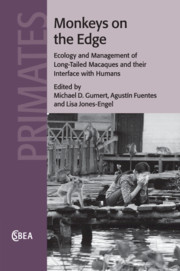Book contents
- Frontmatter
- Contents
- List of contributors
- Foreword
- Preface
- Acknowledgements
- Part I The status and distribution of long-tailed macaques
- Part II The human–macaque interface
- 4 Campus monkeys of Universiti Kebangsaan Malaysia: Nuisance problems and students' perceptions
- 5 Human impact on long-tailed macaques in Thailand
- 6 Macaque behavior at the human–monkey interface: The activity and demography of semi-free-ranging Macaca fascicularis at Padangtegal, Bali, Indonesia
- 7 The role of Macaca fascicularis in infectious agent transmission
- Part III Ethnophoresy of long-tailed macaques
- Part IV Comparisons with rhesus macaques
- Part V Understanding and managing the human–macaque interface
- Index
- References
6 - Macaque behavior at the human–monkey interface: The activity and demography of semi-free-ranging Macaca fascicularis at Padangtegal, Bali, Indonesia
from Part II - The human–macaque interface
Published online by Cambridge University Press: 16 May 2011
- Frontmatter
- Contents
- List of contributors
- Foreword
- Preface
- Acknowledgements
- Part I The status and distribution of long-tailed macaques
- Part II The human–macaque interface
- 4 Campus monkeys of Universiti Kebangsaan Malaysia: Nuisance problems and students' perceptions
- 5 Human impact on long-tailed macaques in Thailand
- 6 Macaque behavior at the human–monkey interface: The activity and demography of semi-free-ranging Macaca fascicularis at Padangtegal, Bali, Indonesia
- 7 The role of Macaca fascicularis in infectious agent transmission
- Part III Ethnophoresy of long-tailed macaques
- Part IV Comparisons with rhesus macaques
- Part V Understanding and managing the human–macaque interface
- Index
- References
Summary
Introduction
Macaca fascicularis is an excellent species to examine adaptation to a particularly wide array of habitats and environmental variables, especially where human impact is a core component of the landscape. Within the long-tailed macaque species (Macaca fascicularis) there are at least ten subspecies, dramatic variation in facial hair patterns, and body size varies from 2.5–7.0 kg for females and 4.7–14 kg for males (Gumert, Chapter 1; Fooden, 1995; Napier and Napier, 1967; Rowe, 1996). Despite their well-documented occurrence and utilization of primary tropical rainforest (up to 2,000m elevation), the long-tailed macaques appear to prefer riverine habitats, coastal forests, swamp or mixed forests and secondary forest habitats (Crockett and Wilson, 1980). The ability to thrive in a variety of environmental types probably played a role in this group's evolutionary success throughout Southeast Asia especially during the last 5–8,000 years of human-induced (agricultural) environmental change.
The island of Bali is approximately 5632 km2 and has a rich history of volcanic activity and thus some of the most fertile soils in the world. There are approximately 247 rivers all cascading down slopes from the central volcanic range. During both the wet and dry seasons moisture accumulates above the volcanoes in the center of the islands providing a nearly year-round supply for the rivers that course rapidly down towards the sea, creating deep ravines and ready access to water for the south central portion of the island.
- Type
- Chapter
- Information
- Monkeys on the EdgeEcology and Management of Long-Tailed Macaques and their Interface with Humans, pp. 159 - 182Publisher: Cambridge University PressPrint publication year: 2011
References
- 18
- Cited by

